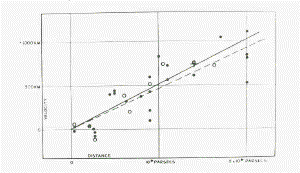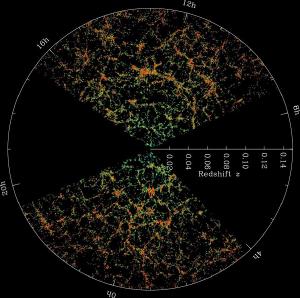Blog
Push Me,
Pull You
26 January 2014
Yesterday I wrote about a galaxy cluster formed by the collision of four clusters. This raised a question by a reader who wondered how galaxies can collide if they are all moving away from each other. The short answer is that they aren’t all moving away from each other, but if the universe is expanding, shouldn’t all the galaxies be racing away from each other? It all has to do with the way cosmic expansion and gravity work, and it tells us something about the nature of dark matter and dark energy.If the universe were not expanding, then you would expect some galaxies to collide with each other. The gravitational attraction between galaxies would cause them to accelerate slowly toward each other, eventually leading to their collision. Some galaxies might be moving to fast to be caught in the gravity of another galaxy, but even then there could be collisions. In a static universe we would expect galaxies to be moving in all directions, with galactic collisions scattered throughout the visible universe.
 Edwin Hubble
Edwin HubbleBut in 1929 Edwin Hubble published a paper showing the universe was not static. He compared the distances of several galaxies with their redshift, and found that their motion followed a relation where the more distant the galaxy, the greater its redshift. This meant galaxies were not simply moving at random, as you would expect in a stable, uniform universe. Instead, the more distant the galaxy the faster it is moving away from us (thus the greater its redshift). This relation between distance and speed is the same in all directions, which means the universe seems to be expanding in all directions.
If these galaxies were all expanding away from a single point (a common misconception about the big bang), then you wouldn’t expect to see many galaxies colliding with each other. In fact, if they all radiated away from a single point, then you would expect the more distant galaxies to spread more thinly than closer galaxies. This isn’t what we see at all.
 Sloan Digital Sky Survey
Sloan Digital Sky SurveyWhat we see is that galaxies tend to clump together in clusters, and those clusters tend to clump into superclusters. Within a cluster or supercluster the galaxies tend to gravitate toward each other, leading to collisions between galaxies here and there. Between the superclusters are large voids where there is very little. What this tells us is that the galaxies aren’t just racing from a single point in space. Instead the entire universe is expanding. It is cosmic expansion that gives the relation between distance and redshift. But even distant galaxies can be moving slowly relative to each other, so they can clump together just as easily as nearby galaxies. So galaxies throughout the universe tend to clump into clusters and superclusters.
What’s particularly interesting is that if you look at the distribution of galaxies in the universe, you find that they clump in a particular way. If the galaxies were just made of matter, then they wouldn’t clump as much as they do. So the level of clumping means there must also be dark matter. The gaps between the galaxies are larger than what you would expect for matter and dark matter alone, so there must be something accelerating the expansion of the universe, which is dark energy.
So rather than galaxy collisions being a mystery, they are actually a part of the obsevational evidence telling us that dark matter and dark energy exist.